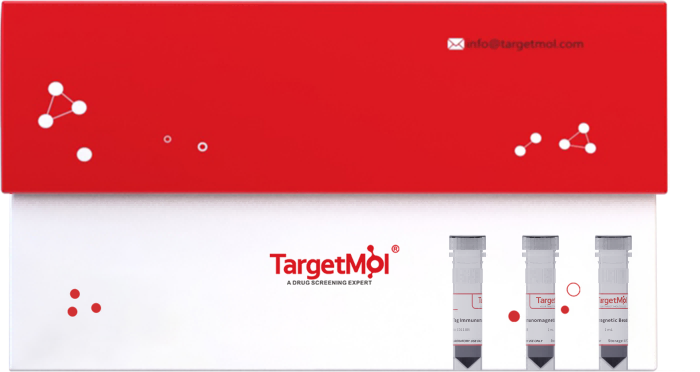 Your shopping cart is currently empty
Your shopping cart is currently empty


mCherry Tag Nanobody Immunomagnetic Beads
Nanobodies (VHHs) are variable domain fragments of heavy-chain antibodies naturally found in camelids (such as camels and llamas). They are the smallest known naturally occurring functional antibody units, typically about 12–15 kDa, which is roughly one-tenth the size of a conventional IgG antibody. Compared to traditional IgG antibodies, nanobodies are smaller, exhibit higher affinity, and are free from heavy and light chain interference. This enables them to access epitopes of target proteins more closely, reduce steric hindrance, remain stably bound, and allow mild elution conditions, thereby preserving higher biological activity of the samples.
| Pack Size | Price | USA Warehouse | Global Warehouse | Quantity |
|---|---|---|---|---|
| 500 μL | $350 | 7-10 days | 7-10 days | |
| 1 mL | $590 | - | In Stock | |
| 5 mL | $2,845 | - | In Stock |
 Product Information
Product Information
| mCherry Tag Immunomagnetic Beads | Features |
|---|---|
| Bead Size | ~30 μm |
| Binding Capacity | ≥ 1.5 mg mCherry Tag Protein/mL Beads |
| Storage Solution | 20 mM PBS, 5% BSA |
| Application | IP, Co-IP, ChIP, RIP |
 Features
Features
1.No Antibody Chain Interference: Whether using denaturing or non-denaturing elution, the immunoprecipitated products are free from antibody heavy or light chains, facilitating downstream Western Blot analysis.
2.Ultra-High Affinity: Exhibits nanomolar-level binding affinity, suitable for low-expression or hard-to-transfect cell samples.
3.Strong Binding Capacity: Directional coupling technology allows 10 μL of magnetic beads to bind approximately 15 μg of target recombinant protein.
4.High Specificity: Validated in over 10 blank cell lines with minimal non-specific adsorption.
5.Flexible Tag Recognition: Specifically binds to mCherry tag at either the N- or C-terminus of the bait protein, offering broad compatibility.
6.Heat Resistance: Tested at 45℃ for thermal stability, ensuring reliable performance during transportation and room-temperature storage.
 Prepare Reagents
Prepare Reagents
| Reagent | Formulation |
|---|---|
| Washing Buffer (1×) | TBST: 50 mM Tris-HCl,150 mM NaCl, 0.1%(v/v) Tween-20,pH7.4 |
| Acidity Elution Buffer | 0.1M Glycine,0.1% (v/v) Tween-20,pH2.5 |
| Neutralization Buffer | 1 M Tris-HCl, pH 9.0 |
 Instructions
Instructions
Preparation of Cell Lysates
Select an appropriate lysis buffer to lyse cell samples and obtain cell lysates. Place on ice or store at -20℃ for long-term use.
Pretreatment of Magnetic Beads
1)Vortex for 1 min to resuspend the immunomagnetic beads. Take 20-30 µL of suspension and place it in a 1.5 mL EP tube.
2)Add 500 μL of Washing Buffer to the EP tube and gently invert several times to resuspend the beads. Keep the EP tube in a magnetic separator and stand for 1 min for magnetic separation. Finally, remove the supernatant and then take off the EP tube. Repeat the washing steps twice.
Immunoprecipitation
(1)Add 500 μL of prepared cell lysates to the EP tube. Place it on a rotating mixer and rotate at 37℃ for 30 min. For weak binding, incubate at room temperature for 1 hour or overnight at 4℃.
(2)After incubation, perform magnetic separation, then remove or save the supernatant for further analysis.
(3)Add 500 μL of Washing Buffer to the EP tube. Perform magnetic separation. Finally, remove the supernatant and then take off the EP tube. Repeat the washing steps 3 times.
Elution of Target Proteins
(1)Denaturing Elution: Suitable for SDS-PAGE detection. Add 100 μL of SDS-PAGE Loading Buffer to the EP tube. Mix well and heat at 95℃ for 5 min. Perform magnetic separation or centrifugation (room temperature, 13000 g, 10 min) to collect the supernatant.
(2)Acidity Elution: Add 100 μL of Acidity Elution Buffer to the EP tube. Incubate on a rotating mixer at 37℃ for 5-10 min. Perform magnetic separation or centrifugation to collect the supernatant. To adjust the pH of acidic elution buffer to neutral, add 50 μL of Neutralization Buffer to 100 μL elution.
Note: Nanobody-conjugated magnetic beads do not have heavy or light chain contamination issues. Denaturing elution is recommended as the first choice due to its higher elution efficiency.
 Storage
Storage
Store at 4℃ for 12 months.
 Precautions
Precautions
1.Avoid freezing the beads. Store in solution to prevent drying.
2.The average magnetic separation time should be longer than 1 min.
3.Ensure uniform suspension by fully shaking the storage tube before use. Avoid bubbles during operation.
4.Use high-quality tips and test tubes to avoid sample loss due to adhesion.
5.Test the binding of proteins to beads by using the collected supernatant.
6.In IP experiments, the binding affinity of different proteins may vary. Users can select and prepare buffers according to experimental needs.
7.The product is for R&D use only, not for diagnostic procedures, food, drug, household or other uses.
8.Please wear a lab coat and disposable gloves.
 Instruction Manual
Instruction Manual
| Size | Quantity | Unit Price | Amount | Operation |
|---|

Copyright © 2015-2025 TargetMol Chemicals Inc. All Rights Reserved.



